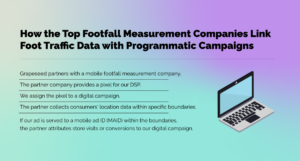Programmatic advertising has transformed the digital marketing landscape, enabling advertisers to automate and optimize ad placements across various online platforms. At its core, programmatic advertising uses algorithms and real-time bidding systems to target specific audiences with tailored messages.
Delving deeper into this powerful strategy, it’s vital to understand the relationship between online ad exposure and offline conversions. This way, advertisers can optimize their programmatic advertising strategies, allocate budgets more effectively, and measure the ROI of their campaigns.
However, attributing offline conversions to online campaigns presents its own set of challenges. Tracking the customer journey from online interactions to in-store purchases can be intricate and convoluted, making it difficult to accurately measure the impact of digital advertising on offline sales.
Below, we explore what goes into connecting foot traffic data with digital advertising campaigns and how Grapeseed helps advertisers do this.
Understanding Programmatic Advertising and Foot Traffic Data
Often dubbed the ‘future of marketing,’ programmatic advertising refers to the automated buying and selling of ad space in real-time through an auction-based system. This technology-driven approach allows advertisers to reach their desired audience at scale, with precision targeting and optimization.
Programmatic advertising offers several benefits. For one, it provides unparalleled efficiency by eliminating the need for manual ad placement and negotiation. Advertisers can leverage advanced algorithms and machine learning to identify the most relevant ad placements and optimize campaigns in real time. This not only saves time and effort, but also ensures maximum return on investment.
Furthermore, programmatic advertising enables advertisers to target specific demographics, interests, and behaviors, allowing for personalized and relevant messaging that resonates with the target audience.
Foot Traffic Data
On the other hand, foot traffic data refers to the information collected about the number of people visiting physical locations, such as retail stores, restaurants, or events. Given that over 40% of consumers prefer in-store shopping, foot traffic data is extremely valuable to businesses.
Mobile location data collection is one of the most accurate methods for collecting foot traffic data. This method tracks user movement and foot traffic by using GPS signals from mobile devices.
Understanding foot traffic patterns reveals valuable insights into consumer behavior, preferences, and trends. This information assists advertisers in making data-driven decisions about their advertising strategies, store locations, and overall business operations. For example, advertisers can use foot traffic data to identify peak visiting hours and popular areas within their store, as well as measure the effectiveness of their marketing campaigns.
Foot traffic data can’t be measured in the absence of a programmatic advertising campaign. When businesses combine programmatic advertising and foot traffic data, they can determine how effective their ads are at driving in-store visits. This information can be used to improve future campaigns and ad budget allocation decisions. But how do advertisers link the two?
The Art of Connection: How Foursquare, Adsquare, and inMarket Link Foot Traffic Data with Programmatic Campaigns
As advertisers strive to bridge the gap between online campaigns and offline conversions, Foursquare, Adsquare, and inMarket have emerged as key players in the space, using their advanced technologies and innovative approaches to help brands attribute offline conversions to programmatic campaigns.
Here are the proprietary technologies these three industry leaders use:

Foursquare
Foursquare uses its Movement SDK (Software Development Kit) to help businesses understand user behavior based on real-time information about their location. The Movement SDK achieves this by establishing geofences around specific locations such as retail stores and restaurants. As users enter or exit these geofenced areas, the SDK installed on their smartphones detects these movements.
However, Foursquare’s approach extends beyond geofencing, harnessing the power of machine learning algorithms to determine the context of these visits. By considering various factors like the duration of time spent at a location and the frequency of visits, Foursquare can differentiate between individuals who merely pass by a store and those who actually visit it.
When an advertiser launches a campaign through Foursquare or uses Foursquare’s data, the platform tracks ad impressions. If a user exposed to the advertisement subsequently visits the corresponding physical store, the Movement SDK captures this offline conversion and attributes it to the ad campaign. This capability allows advertisers to measure the effectiveness of their campaigns and gain insights into how online advertising translates into offline actions.
Adsquare
Adsquare’s Audience Management Platform (AMP) allows advertisers to access and manage various data dimensions, including offline data such as foot traffic. The platform enables precise and efficient targeting by accessing anonymized mobile device IDs and their associated data points, resulting in improved advertising accuracy and relevancy.
Understanding the movement patterns of these anonymized device IDs is the basis of Adsquare’s foot traffic analysis. The platform can identify instances where people spend a significant amount of time within predefined geographical boundaries by tracking the location data of these devices. These are recognized as store visits, indicating that the device user physically entered a specific store or location.
To attribute the store visits to ad campaigns, Adsquare connects ad exposure data (which device IDs have been served which ads) with foot traffic data. If a device ID that was served an ad is later detected in the store location, the visit is counted as an offline conversion attributed to that specific ad campaign.
InMarket
Leveraging first-party, SDK-verified location data, InMarket enables advertisers to create personalized, real-time engagements while consumers are in-store, thus improving brand engagement.
InMarket’s technology tracks SDK-integrated mobile device IDs and monitors the location data associated with these devices. Similar to Foursquare and Adsquare, InMarket identifies instances when these devices enter a store location, indicating a store visit.
Attribution to ad campaigns involves connecting ad exposure data with store visit data, enabling the identification of offline conversions that are linked to the ad campaign.
It’s important to note that these attribution techniques are designed to respect user privacy. They typically involve anonymized and aggregated data, ensuring the protection of individual identities. Users also have the option to opt out of location tracking, providing them with control over their data.
The Role of Partners like Grapeseed Media in Bridging the Gap
Footfall measurement companies like Adsquare and Foursquare take care of foot traffic data measurement and attribution, but it’s agencies like Grapeseed that create the tailored advertising campaigns.

To do this, we approach programmatic advertising campaigns with meticulous planning, strategic execution, and ongoing optimization. Here’s an overview of how we build programmatic advertising campaigns, recognizing our critical role in facilitating measurement by driving foot traffic with our advertising campaigns:
- We use premium data sources to ensure campaigns reach the right people at the right time.
- We offer expertly crafted campaigns that employ a variety of channels, including CTV, digital audio and video, and DOOH.
- We work closely with clients to define clear campaign objectives, segment audiences, and develop compelling ad formats.
- We continuously monitor campaigns. This allows us to seamlessly optimize campaigns and shift resources toward the most effective advertising channels for maximum results and financial efficiency.
Combining the expertise of footfall measurement companies with our creativity allows businesses to create tailored advertising campaigns that are more effective and efficient.
Consider how, in collaboration with Adsquare, we were able to increase the number of consumers who visited a pizza chain, measuring over 36,000 walk-in visits. By attributing the store visits to a programmatic ad campaign in real time, the pizza chain was able to focus ad spending on the most effective ads, thereby maximizing ROI.
Enhancing Footfall Attribution with Grapeseed
You can bridge the gap between your online and in-store business efforts by harnessing the power of foot traffic data and integrating it with programmatic advertising campaigns. This link enables you to deliver precisely targeted and personalized advertisements to consumers based on their real-world behavior.
Looking ahead, continuous advancements in technology and data analytics will enhance the precision of audience targeting, allowing for even more innovative and effective advertising strategies that drive foot traffic, sales, and foster brand loyalty.
To fully realize the benefits of this advertising strategy, it’s a good idea to partner with a company that specializes in this field. Grapeseed, along with renowned partner agencies like Foursquare and Adsquare, are industry leaders in connecting foot traffic data with programmatic advertising. Our extensive expertise, tools, and technology provide a significant competitive advantage in today’s market.
The convergence of data and technology is the future of advertising, and businesses that embrace this evolution will undoubtedly reap the benefits. Contact the Grapeseed team to learn more about how you can start linking your footfall and programmatic campaigns effectively.






